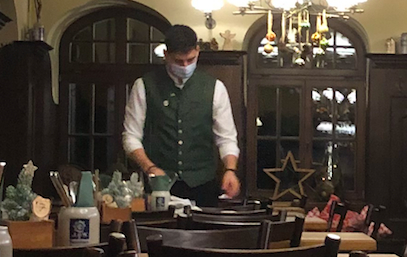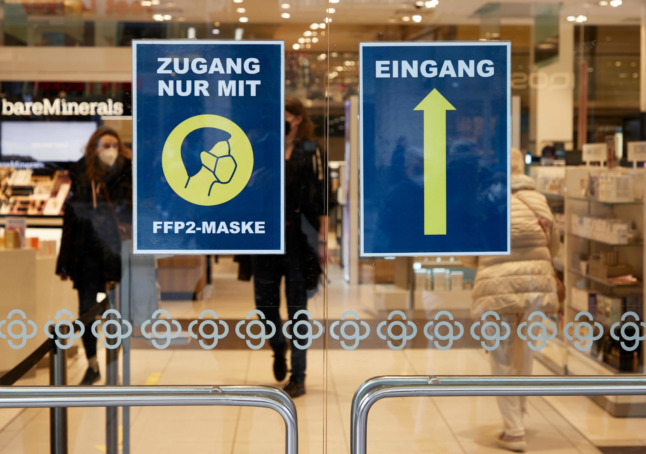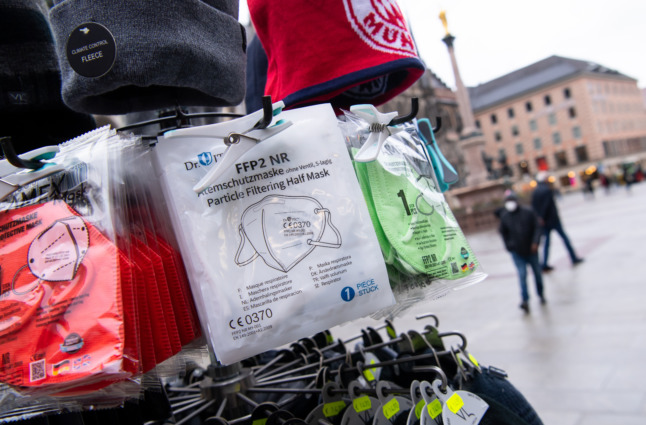International travel in the Covid era is not a matter of packing a bag, grabbing your passport and heading to the airport; rather, it’s managing a series of evolving airline and government regulations in order to arrive at your destination.
Here’s what it took for this traveller based in Santa Fe to get to Germany twice in 2021, first in early September and then for the Holidays in December 2021, noting any changes over the course of those two trips.
LEAVING THE USA
To board my flights in America, I needed three items: a passport, medical grade or N95/KN95 mask and my CDC issued vaccination card. There was also a third requirement that had to be met within three days of entry into Germany, and that was to register with the German authorities via their “Digital Entry Registration” website.
Based on the status that applies to your country of origin at the time of the submission, the user-friendly website will either have you enter the specific details of your itinerary, or determine that you are not coming from a high-risk area and terminate the session.
For my trip in September, I had to complete the full registration process, which took about 10 minutes, and then print out a three-page document to present to Border Control upon landing. For traveling in late November, the website said that I was not coming from a high-risk area and did not need to register, ending the session at about three minutes.
Please note that the USA has been deemed a high-risk area as of December 25th, 2021, so completing the registration process is a mandatory step for Americans who currently want to fly to Germany at the moment. Also, you can only register within three days of your landing as that is the date when you enter Germany.
READ ALSO: What you should know about travel to Germany during the Omicron wave
TWO FINAL RECOMMENDATIONS ON DEPARTURE
First, get to the airport three hours prior to takeoff to avoid any last-minute chaos with respect to documentation, as airline employees have a greater work burden in these pandemic times.
Secondly, wear a N95/K95 mask on the plane. Yes, medical masks are sufficient for flying, but they do not meet current German guidelines and you will have to purchase a qualifying FFP2 model soon after arrival in order to enter businesses. Since N95/K95 masks are considered equivalent to FFP2, you will be fully compliant upon landing if you are wearing one.
LANDING IN GERMANY
The Border/Customs Control experience for both trips was routine; a simple review of my passport and CDC issued vaccination card. Interestingly, the Border Agent did not ask for my Registration for Entry papers that I carried in September. I did, however, give it to him and he looked at it, saw my name on the first page, smiled and handed it back to me.
ON THE GROUND AND IN TOWN, FROM BEST PRACTICES TO 2G
In September, a medical mask, ID, official vaccination card and completing a contact tracing form was all an individual needed to enter an establishment and be seated. That changed for the 2021 winter trip, as “2G,” (Geimpft oder Genesen – vaccinated or recovered), was the rule.
Put simply, 2G means wearing a FFP2 quality mask, providing ID and showing proof of vaccination (or recovery) to access venues such as bars, restaurants and hotels. Exceptions are in “to go” circumstances. For example, buying a cup of coffee at a cafe to go means wearing the proper mask to enter the establishment. If a customer wants to take a seat and drink it there, he or she has to show ID and proof of vaccination before sitting down at a table.

On the subway under 3G rules (meaning that unvaccinated people could travel too, but had to have proof of a negative Covid test with them), transportation employees in yellow vests stood on the platforms of some high traffic stations, e.g. Marienplatz, to make sure that people wore masks, but not at the more remote locations. Amazingly, I did not see one person on an U Bahn, S Bahn, Bus or Tram who was not wearing a mask. Sure, some noses weren’t covered, but the level of mask compliance on public transportation in Munich was exceptional.
To enter a restaurant, signage instructs guests to wait near the entrance in order to show their vaccination status to an employee before being directed to a seat. Locals would present digital proof of vaccination on their Smartphones and I provided my CDC issued card and state issued driver’s license. One might think that the process would produce a bottleneck at the establishment’s entrance, but the wait never took longer than 2-3 minutes, often less.
Once your vaccination status was validated, you wore your mask to the table, then took it off while seated, putting it back on to visit the bathroom and to leave the establishment.
Most hotels have a clear plastic barrier at the front desk and guests need to be FFP2 mask-compliant, provide proof of vaccination and show a personal ID at check-in. Supermarkets, pharmacies, drugstores and many other retail outlets also have plastic shields at their registers and each business requires a qualifying FFP2 mask to enter. Small shops, such as bakeries, would post signs about how many people were allowed indoors at one time and customers uniformly followed the rules, queueing up on sidewalks waiting to enter the store when the maximum number of people were inside, only entering after a person left.
People of all ages did an admirable job of following the recommended best practices, flowing in and out of business establishments without incident. On the handful of occasions where I witnessed someone entering a space with the wrong mask, the merchant would politely inform the person of the need to upgrade their mask in order to enter the store.
Overall, my perspective to the Covid rules compliance was limited to seven weeks in Munich, but the observed execution of its implementation was impressive. Most important, the regulations did not seem to diminish anyone’s capacity to run their errands and/or share in the Holiday spirit.
MORE ON MASKS, TESTING SITES AND SELF TESTS
Buying quality masks is easy in Germany. They are available at supermarkets, drugstores, convenience stores and general merchandise retail outlets. I even saw a bakery sell an FFP2 mask to a customer who walked in wearing a medical mask.
The only incongruent aspect of the mask rule is that the model-specific mandate does not apply to the employees of the establishment, whether it be a bakery, restaurant, hotel, coffee shop, bar or supermarket. In other words, employees can wear medical masks – and most do. Don’t let that mislead you into thinking that you as a tourist can do the same.

A welcome surprise were the ubiquitous pop-up rapid testing sites and retail store fronts converted into testing outlets. Rapid tests (Schnelltests) were free – yes, free – and no appointment was necessary, though it was possible to make one for some of the locations. The rapid tests were for Munich residents only in September, but open to anyone in December.
To get a rapid test, all I had to do was wear a mask, sign in with an ID and contact information, get swabbed and then wait 15 minutes for the result. Pharmacies also sell self-testing Covid kits that cost around €5 and are easy to use. I made a point to get tested once a week, either at one of the Schnelltest locations, or via a self-test administered in my hotel room.
As an American not accustomed to this type of public health outreach, it was obvious that the German rapid testing model should be implemented at home and around the globe. Not only is it a great resource in containing and monitoring the pandemic, it is a vital tool in providing peace of mind to individuals and the community at large.
THE COVID ERA MINDSET
Make no mistake. Covid has negatively impacted Germans and their preferred routines. The famed Christmas Market that normally dominates Munich’s Marienplatz, for example, was cancelled, but Holiday cheer existed elsewhere; at the Viktualenmarkt and at smaller neighbourhood squares such as Wienerplatz, places where Glühwein was served and people gathered to celebrate.
As a visitor, it was a simple matter of adjustments. For example, the Nürnburger Bratwurst Glöckl am Dom restaurant has a “Stehausschank,” where customers buy a beer at a window located inside a side door to the building and then stand in the adjacent courtyard to enjoy it. Due to G2 rules, the Stehausschank was closed, but the workaround was easy, as it took ten seconds to walk to the front of the restaurant, find a seat under a heat lamp and order a beer from a waiter. It might not have been the Stehausschank experience, but it was a perfect Augustiner Bier just the same.
It was clear, though, that the merchants and people of Munich did not let the Covid Grinch steal their Christmas. Things might have taken a little extra time, or were done on a smaller scale, but not at the expense of enjoyment. If anything, the additional barriers were a reminder to be grateful for what was possible, a timeless lesson for all.
RETURNING TO THE UNITED STATES
Flying back to the United States requires logistical discipline as travellers need a negative viral Covid test result within one day of the return flight. Some of the ubiquitous rapid tests do not meet the requirement in place, so I got a PCR test. The issue with the standard PCR test is that the results normally take up to 2-3 days to post. Therefore, you need to find a testing site that can return a same day result. I was told that are two such locations: one at the famed Deutsches Museum and the other at the Verkehrszentrum Museum (transportation museum), which is near Bavaria Park and the Theresienwiese, the Oktoberfest site.
For those taking public transportation, the Verkehrszentrum Museum location is a four-minute walk from the Schwanthalerhöhe U Bahn station (lines U4 and U5). For individuals opting to use the Deutsches Museum test site, it is a ten-minute walk from the Fraunhoferstrasse U Bahn Station (lines U1 and U2).
I used this site to book a PCR test. The PCR test costs €75 and you need to keep the receipt as it will have the pin number that enables you to retrieve your test result via the service provider’s website. They will not send you the result via email or text. You have to access it online using the pin number on your receipt. Once you get the test result, download it and email it to your hotel’s Front Desk to print out so you can bring it to the airport and check-in for your flight.
There is drop-in availability for the PCR test with same day results, but there are no guarantees of availability. Therefore, it is best to make an appointment online first. If you have issues navigating, or aren’t traveling with a smartphone or computer, ask for assistance in making an appointment at the front desk of your hotel.
I used both testing locations, the Verkehrszentrum Museum in the Fall and the Deutsches Museum in winter. Be advised that the former is located on the back side of the Verkehrszentrum Museum entrance and the latter about 100 meters north of that museum’s main entrance, so don’t panic if the testing site is not immediately visible as you approach the location. In both places, the professionals who provide testing services are top-notch and can answer any questions in English if you don’t speak German.

FINAL THOUGHTS, REMINDERS & RECOMMENDATIONS
Regulations can change at any time, so contact the airline close to the date of your departure from the United States, e.g. five days, to make sure that you are aware of the latest requirements to board your flight and enter Germany.
Don’t forget #1, before you depart for Germany: register via the Digital Registration on Entry website. As noted, registration is only open three days in advance of your entry date, so set a reminder in your calendar with that in mind. Once registration is completed, the website will generate a three-page document for you to print so you can hand it to the Border/Customs representative when you enter Germany.
Keep up with the risk status of the US (or the country you’re travelling from) on Germany’s Robert Koch Institute list.
Don’t forget #2, before you return to the USA: after receiving your negative PCR test result, download it and email it to the front desk of your hotel so they can print it out. You will need to show it to the airline in order to board your flight.
There is also an Attestation of vaccination document that Lufthansa recommended to fill out and have handy. I was not asked for it upon returning to the USA for either trip, but it is advisable to carry a copy with you, printing it out before you leave for Germany, and then filling it out upon your return. If someone asks for it upon landing, you will be prepared.
For those who are virus shy and are uncomfortable being in crowded places, a few conscious decisions of small dimensions can make a difference in your enjoyment of the travel experience. One idea, for example, is to eat at non-traditional hours, either early or late, to avoid large gatherings of people indoors. Gauge the ventilation when you enter the space. If it feels stuffy or poorly ventilated, leave and eat elsewhere. Also, avoid public transportation during commute hours as the trains, buses and trams can get crowded at those times.
A protective plastic encasement for your CDC issued card is worth sourcing. I bought one at CVS for $2.
The hospitality workers and service providers are the superstars who make our travels possible. If you can, try to tip those who serve you, even if it is not much money, as the utility of the gesture will yield far more than the value of the gratuity. Not only will people respond graciously to you, but your congeniality will help them pay it forward to the next guest they greet.
Finally, never forget that the circulation of positivity is a gift that you can bring to each encounter, so smile and enjoy yourself. It’s the good kind of contagious!
TRAVEL CHECKLIST
Items needed to travel from the USA to Germany and back:
Airline, USA to Germany: mask, CDC issued proof of vaccination + passport.
German Border Control: mask, proof of vax + passport + registration for entry papers.
Hotel: FFP2 mask, proof of vax + ID (passport or state issued driver’s license).
Sit-down dining, or bar: FFP2 mask, proof of vax + ID (passport or state issued driver’s license). Editor’s note: Under 2G-plus rules, vaccinated/recovered people need a negative Covid test or proof of a booster shot.
Supermarket and other stores: FFP2 type mask (medical + cloth masks are not sufficient).
Airline, Germany to USA: mask, proof of vax + passport + negative Covid test (PCR).
American Border Control: mask, proof of vax + passport + attestation.



 Please whitelist us to continue reading.
Please whitelist us to continue reading.
This has to be one of the best written articles of any kind that I have read in a very long time. Phil Schaaf should be commended.
Some airlines/airports are misrepresenting Germany’s rules. My husband flew back from the US last week and showed his proof of full vaccination. They claimed Germany required a negative test as well. This is NOT true. He showed them the German government site in English where it was clearly not required. He showed then their own website where it isn’t required. The woman insisted and said it could be done right then and there for a “convenient” $300. What choice did he have? He had to come home. HIGHWAY ROBBERY!